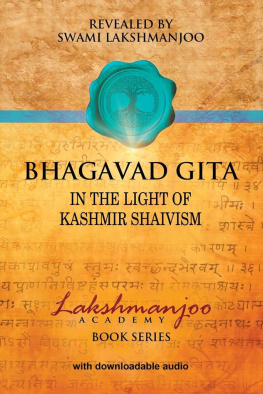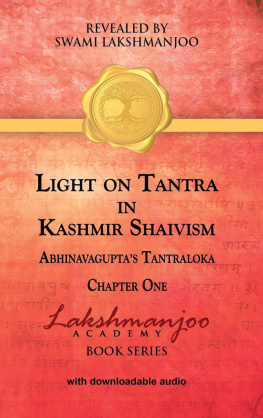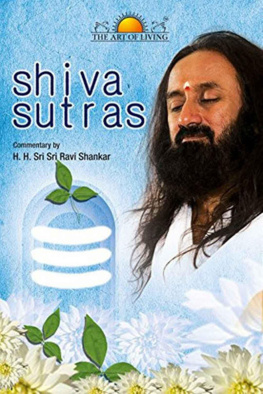The
Reality
Sutras Seeking the Heart
of Trika Shaivism
Jaya Kula Press
110 Marginal Way, #196
Portland, Maine 04101
jayakula.org
2018 by Shambhavi Sarasvati
All rights reserved. No part of this book may be reproduced in any form, or by any means, without permission in writing from the publisher.
Cover and interior design and layout: Saskia Nicol
saskianicol.com
Library of Congress Control Number: 2018904586
Sarasvati, Shambhavi
The Reality Sutras: Seeking the Heart of Trika Shaivism
ISBN:
978-1-7322183-0-7 (pbk) 978-1-7322183-1-4 (ebk)
Printed in the United States of America on acid-free paper.
The
Reality
Sutras Seeking the Heart
of Trika Shaivism Shambhavi Sarasvati
Jaya Kula Press Books
by Shambhavi Sarasvati
Pilgrims to Openness: Direct Realization Tantra in Everyday Life , 2009
The Play of Awakening: Adventures on the Path of Direct Realization Tantra , 2012
Returning: Exhortations, Advice and Encouragement from the Heart of Direct
Realization Practice , 2015
No Retreat: Poems on the Way to Waking Up , 2016
Nine Poisons, Nine Medicines, Nine Fruits , 2017
The Reality Sutras: Seeking the Heart of Trika Shaivism , 2018
My wish is to be neither an ascetic
Indifferent to the world
Nor a manipulator of supernatural powers
Nor even a worshiper craving liberation
But only to become drunk
On the abundant wine of devotion.
Utpaladeva, Shaiva Devotional Songs of Kashmir
As far as the space of the universe extends, so far extends the space within the heart. Within it are contained both heaven and earth, both fire and air, both sun and moon, lightning and the stars.
The Chandogya Upanishad
CONTENTS
For disciples and devotees of that
______________
Two Handfuls of Rice
I am writing this book as a small offering to my students and to all those who desire to better understand the View of Trika Shaivism, also known as Shaiva Tantra. Students of other direct realization traditions, such as Dzogchen and Chan Buddhism, will find much resonance here.
The Sanskrit word for View is darshan . In Tibetan, View is tawa . View has a few special meanings in direct realization traditions. It means both to see and what we see as a result of doing spiritual practice. It also means the instruments through which we see and a way of living that embodies the wisdom we directly encounter through spiritual practice.
View teachings let us know what our traditions have to say about existence, cosmology, the self, God, consciousness, and realization. In the direct realization traditions, we say: Learn the View, practice with the View, embody the View . When we have recognized our real nature and, through practice, come to embody the teachings in our perceptions and activities, we are said to be living the View.
Studying the View of your tradition is critical to practicing correctly. This is easy to understand. If I go for a walk in the woods, and my orientation is that I am trying to catch a glimpse of a certain rare bird, I may find that bird. If my orientation is that I am simply walking along and enjoying being outside, I will likely achieve that, but I probably will not find the bird.
Likewise, some people perform rituals with the View that they are propitiating great beings in order to accumulate merit. In direct realization traditions, we are more likely to perform ritual with the View that we are trying to recognize our own, already perfect wisdom nature through the medium of the ritual. To a great extent, the View with which you practice determines the result. For this reason, it is important to understand the View of any tradition in which you are participating so that you can practice correctly and move without undue delay toward realizing what that tradition has to offer.
View and the role of textual study
In direct realization traditions, the teacher, the teachings, and the practices you do all help you to directly recognize or encounter your primordially enlightened nature. You directly realize the nature of your self, of reality, through a process of opening the gates of the senses, including the mind.
The word in Sanskrit for direct realization is pratyakshadarshana . Pratyaksha means direct. So pratyakshadarshana means directly experiencing or having the darshan of the ultimate nature of reality with your own senses. Direct realization is not primarily an intellectual understanding; it is 100% embodied, useable, experiential wisdom about how you and life actually are.
Despite popular and erroneous notions that direct realization traditions are all about effortless, sudden enlightenment, both sadhana (spiritual practice) and textual study are emphasized. In combination with oral instruction and practice, studying the texts of a tradition helps us to clarify, enlarge, and guide our understanding of View.
Some students approach text study in a more intellectual way as if they were reading philosophy or theory. But for a student who is ripe, reading about the View can act as a potent catalyst for directly relaxing constricting patterns of body, energy, and mind. For this reason, students are advised to read and also to meditate on key teaching texts.
What kind of book is this?
The Reality Sutras is a handbook of View teachings. I am doing my best to make essential aspects of the View of my Indian tradition accessible to contemporary students. For the most part, I am reporting on what I have discovered for myself through engaging in spiritual practice. My hope is that The Reality Sutras will inform, but foremost that it will serve as a source of contemplative material for practitioners. Occasionally I enrich a passage with a quote from my root Guru, Anandamayi Ma. She was not a teacher of Trika Shaivism, but her teachings were always about directly realizing the nature of the Self.
You wont find many footnotes here. I am not making a conventional effort to convince you that I know what Im talking about or that my traditions View of reality is one you should adopt. More than proving something to your intellect, I would prefer to move you. From my perspective, the only desirable proof of my little offering is whatever response of yes you discover within yourself and then whatever unfolds after that.
With infinite love,
Shambhavi
Portland, Maine
Reality is knowable
The nature of reality, your own nature, is an open secret announcing itself everywhere and always available to be directly known and more fully embodied.
Many spiritual traditions hold the View that reality is unknowable or a mystery. This makes sense only if what you mean by knowable is explainable. Of course, we cannot capture and explain every aspect of reality with words or even with numbers.
Lets say you take a workshop describing all of the different styles of meditation, their histories, and how people have practiced in different spiritual traditions. You even read some scientific studies about the effects of meditation. But after a long period of gathering descriptions, explanations, and information, you still do not have much understanding of meditation. In order to have real knowledge of meditation, you have to meditate!
Meditation and other spiritual practices require you to engage your body, your energy, and your mind. They are embodied, experiential, and immersive. Knowing in the direct realization spiritual traditions means that by doing spiritual practices such as meditation, you can directly discover the real nature of the Self and existence. Using your five senses and your mind, you can find out who and what you are and how things work.
The discovery of your real nature is not just information. It is embodied knowledge. By practicing just with your body, energy, and mind, you transform your moment-to-moment experience. You begin to have spontaneous insights into fundamental processes of reality. You enter into a rich conversation with our alive, aware world. You ultimately discover the capacity to interact directly with the subtlest aspects of nature, including space and time.
Next page











